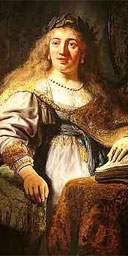
In the city where the euro was born, there's no shortage of opportunities to spend them. Maastricht has adopted the slogan 'The art of fine living', and is determined to ensure that you do just that in this charming and culture-rich city.
Every year in early March, the world's leading art dealers gather for the TEFAF - the European Fine Art Fair. This year, over 200 art and antique dealers from 13 countries have gathered at the vast conference and exhibition centre (MECC) to display their choicest goods.
The range of art and antiques is vast. Where else in Europe can you currently see a Rembrandt, Monets, Chagalls, rare paintings and etchings by Picasso, a Brueghel or two, Henry Moore sculptures, a Cranach, Chinese Tang dynasty pottery, or a recently discovered Michelangelo drawing, all within a few hundred metres of each other?
From a gruesome collection of memento mori, to the glittering display of huge rubies, emeralds and diamonds on the jewellery stands, from exquisitely detailed books of hours to a stand full of antique clocks that draws visitors on the hour as each clock chimes, there are endless amounts of objects both beautiful and bizarre. The atmosphere has the best of a museum (you're free to wander at will), but the commercial nature of the thing means there's a buzz in the air: you don't get any of the stuffiness and arm's length approach that can make museum visits less than appealing.
All eyes were on a huge Rembrandt, Minerva in her Study. The work has been in private hands for many hundreds of years and, despite its loan to a Tokyo museum, has remained little known in the west, much of its beauty obscured by a thick layer of discoloured varnish. Today, restored and magnificent, it's on sale for $40m; an armed guard stands beside the glass case 24 hours a day, while Minerva, the goddess of war, her shield and helmet close to hand, appeared unmoved by all the fuss she was creating.
Business was brisk during the fair's first week, and visitor numbers looked set to be up on last year's 75,000. Visitors are predominantly north Europeans - Maastricht's location, with Belgium and Germany under an hour away, and northern France and the UK easily accessible, make it an easy day trip for many. Representatives from most of the west's major museums were in attendance, and during the opening weekend it was not rare to see objects move from one stand to another, as fellow dealers appraise each other's stock with an eye out for bargains themselves.
Maastricht itself has a great deal to offer a weekend visitor. The week I visited, the modern and spacious Bonnefanten Museum on the edge of the river Maas was celebrating the long term loan of a number of important works from Amsterdam's Rijksmuseum. The museum has a good collection of old master painting and sculpture, as well as some exquisite early wood carvings, silver and glass ware, and modern art represented by the likes of Sol LeWitt, Bruce Naumann and Gary Hume.
Look out for Metsijs's Return of the Prodigal Son, in which, if you look closely, you can see a figure hidden in the rock - the artist clearly thought better of his original subject matter and made extensive changes to his painting, including turning a sitting figure into a rock. You can also see, on Pieter Gissels's Marktgezicht, the faint lines of perspective the artist drew to guide himself. As the paint has faded, these lines have stubbornly refused to dim too.
The old and new co-exist with remarkable tranquillity here. The city's Roman remains - 4m below street level - provide a dramatic subterranean backdrop for breakfasting guests in the cellar of the Derlon hotel.
The medieval city walls are more easily accessible. Pick up the city walk map at the tourist office, and follow the circular route they suggest. You'll pass the Netherland's oldest city gate - the Helpoort, built in 1229. Opposite the gate, is the 'Plague house', a former water mill, now a theatre.
Two churches sit side by side in Vrijthof Square. The street in between the Catholic and Protestant buildings is known as Purgatory Lane. If you're worried about your spiritual health, English mass is said on Saturdays in the crypt of the 15th century Church of Our Beloved Lady (Onze Lievevrouwebasiliek). The square outside this church is lined with cafes, and some of Maastricht's most luxurious shops and boutiques are to be found on the adjoining streets.
If you're visiting during TEFAF, it's advisable to book restaurants well in advance, but the rest of the year, you'll be spoilt for choice. Maastricht has more fine restaurants than a city of this size would be expected to have, and many Belgians, French and Germans cross the nearby borders to dine in the gustatory capital. One restaurant, Magnifiek, not only serves superb food, but has a gallery downstairs of 18th and 19th century Flemish art. You can even combine your art buying with your dining. The art of fine living indeed.
* TEFAF closes on March 17. Entrance is 30 euros for a single ticket, or 42.50 for a double ticket, which includes a catalogue.
Useful links
Maastricht tourist board
TEFAF
Bonnefanten museum
Maastricht city guide

